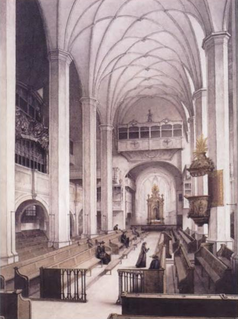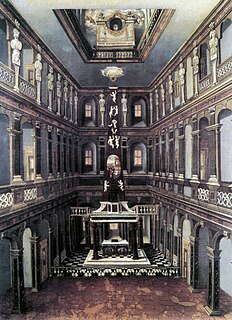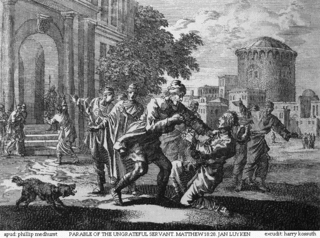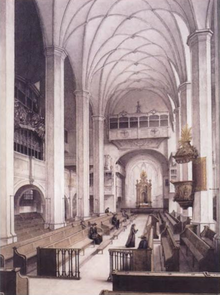
Ach Gott, wie manches Herzeleid, BWV 3, is a church cantata by Johann Sebastian Bach. He composed the chorale cantata in Leipzig for the Second Sunday after Epiphany and first performed it on 14 January 1725. It is based on the hymn published by Martin Moller in 1587.

Johann Sebastian Bach composed the church cantata Es ist das Heil uns kommen her, BWV 9 in Leipzig for the sixth Sunday after Trinity between 1732 and 1735. It is a chorale cantata, based on the hymn "Es ist das Heil uns kommen her" by Paul Speratus. Bach composed the cantata to fill a gap in his chorale cantata cycle written for performances in Leipzig from 1724.

Jesu, der du meine Seele, BWV 78 is a church cantata of Johann Sebastian Bach. He composed the chorale cantata in Leipzig for the 14th Sunday after Trinity and first performed it on 10 September 1724. It is based on the hymn by Johann Rist.

Johann Sebastian Bach composed the church cantata Ich hatte viel Bekümmernis, BWV 21 in Weimar, possibly in 1713, partly even earlier. He used it in 1714 and later for the third Sunday after Trinity of the liturgical year. The work marks a transition between motet style on biblical and hymn text to operatic recitatives and arias on contemporary poetry. Bach catalogued the work as e per ogni tempo, indicating that due to its general theme, the cantata is suited for any occasion.

Ach Gott, wie manches Herzeleid, BWV 58, is a church cantata by Johann Sebastian Bach. He composed the dialogue cantata in Leipzig for the Sunday after New Year's Day.

Jesus schläft, was soll ich hoffen?, BWV 81, is a church cantata by Johann Sebastian Bach. He composed it in 1724 in Leipzig for the fourth Sunday after Epiphany and first performed it on 30 January 1724.

Unser Mund sei voll Lachens, BWV 110, is a church cantata by Johann Sebastian Bach. He composed the Christmas cantata in Leipzig for Christmas Day and first performed it on 25 December 1725.

Johann Sebastian Bach composed the church cantata Ich geh und suche mit Verlangen, BWV 49, in Leipzig for the twentieth Sunday after Trinity Sunday and first performed it on 3 November 1726. It is a solo cantata, a dialogue of soprano and bass.

Ärgre dich, o Seele, nicht, BWV 186 is a church cantata by Johann Sebastian Bach. He composed it originally in Weimar in 1716 for Advent, BWV 186a, and expanded it in Leipzig in 1723 for the seventh Sunday after Trinity, where he first performed it on 11 July 1723.

Vox Christi, Latin for Voice of Christ, is a setting of Jesus' words in a vocal work such as a Passion, an Oratorium or a Cantata. Conventionally, for instance in Protestant music of the Baroque era, the vox Christi is set for a bass voice.

Johann Sebastian Bach composed the church cantata Du Friedefürst, Herr Jesu Christ, BWV 116, in Leipzig for the 25th Sunday after Trinity. He led the first performance on 26 November 1724, concluding the liturgical year of 1724.

Selig ist der Mann, BWV 57, is a church cantata by Johann Sebastian Bach. He wrote the Christmas cantata in Leipzig in 1725 for the Second Day of Christmas, which was celebrated that year as St. Stephen's Day, and first performed it on 26 December 1725.

Sie werden aus Saba alle kommen, BWV 65, is a church cantata by Johann Sebastian Bach. He composed it in 1724 in Leipzig for Epiphany and first performed it on 6 January 1724 as part of his first cantata cycle.

Mein liebster Jesus ist verloren, BWV 154, is a church cantata by Johann Sebastian Bach. He composed it for the first Sunday after Epiphany and first performed it in Leipzig on 9 January 1724.

Sehet, wir gehn hinauf gen Jerusalem, BWV 159, is a church cantata by Johann Sebastian Bach. He composed it in Leipzig for the Sunday Estomihi, the last Sunday before Lent, and probably first performed it on 27 February 1729. The gospel reading for the Sunday, from the Gospel of Luke, includes Jesus announcing his suffering and death in Jerusalem. The cantata's theme and Bach's music foreshadow his Passion.

Johann Sebastian Bach composed the church cantata Herr Jesu Christ, du höchstes Gut, BWV 113 in Leipzig for the eleventh Sunday after Trinity and first performed it on 20 August 1724. The chorale cantata is based on the hymn "Herr Jesu Christ, du höchstes Gut" by Bartholomäus Ringwaldt (1588).

Johann Sebastian Bach composed the church cantata Schmücke dich, o liebe Seele, BWV 180, in Leipzig for the 20th Sunday after Trinity and first performed it on 22 October 1724.

Meinen Jesum laß ich nicht, BWV 124, is a church cantata written by Johann Sebastian Bach. He composed the chorale cantata in Leipzig for the first Sunday after the Epiphany and first performed it on 7 January 1725. It is based on the hymn "Meinen Jesum laß ich nicht" by Christian Keymann.

Johann Sebastian Bach composed the church cantata Mache dich, mein Geist, bereit, BWV 115, in Leipzig for the 22nd Sunday after Trinity and first performed it on 5 November 1724. The chorale cantata is based on the hymn by Johann Burchard Freystein (1695).

Der Herr ist mein getreuer Hirt, BWV 112, is a cantata by Johann Sebastian Bach, a church cantata for the second Sunday after Easter. Bach composed the chorale cantata in Leipzig and first performed it on 8 April 1731. It is based on the hymn by Wolfgang Meuslin, a paraphrase of Psalm 23 written in 1530, sung to a melody by Nikolaus Decius.















